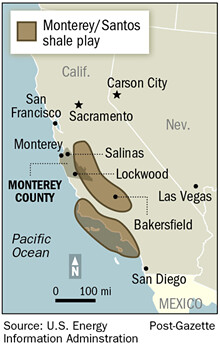California is home to AB32, the Global Warming Solutions Act of 2006 authored by State Senator Fran Pavley that caps and trades carbon pollution, mandates lower carbon fuel, higher mileage from automobiles, energy efficiency, and puts the state at the forefront of the clean energy economy.
 California is also home to 15 billion barrels of oil that now can be easily recovered using modern fracking technology. The state has always had some oil, as anyone who’s ever seen There Will Be Blood or cleaned up a Santa Barbara spill can attest. But the wells got old, and most of the good milkshakes got drank, until fracking – the art of using a very long bendy straw – came along. And now Venoco, Occidental Petroleum, and others are salivating at the thought of fracking up California. The New York Times’ story on vast oil reserves now within reach has gotten national attention. Rightwing papers are asking: could the Monterey Shale save California? (never mind that California saved itself by depriving Republicans of their hostage-taking abilities). From the Times:
California is also home to 15 billion barrels of oil that now can be easily recovered using modern fracking technology. The state has always had some oil, as anyone who’s ever seen There Will Be Blood or cleaned up a Santa Barbara spill can attest. But the wells got old, and most of the good milkshakes got drank, until fracking – the art of using a very long bendy straw – came along. And now Venoco, Occidental Petroleum, and others are salivating at the thought of fracking up California. The New York Times’ story on vast oil reserves now within reach has gotten national attention. Rightwing papers are asking: could the Monterey Shale save California? (never mind that California saved itself by depriving Republicans of their hostage-taking abilities). From the Times:
Comprising two-thirds of the United States’s total estimated shale oil reserves and covering 1,750 square miles from Southern to Central California, the Monterey Shale could turn California into the nation’s top oil-producing state and yield the kind of riches that far smaller shale oil deposits have showered on North Dakota and Texas.
California’s 15 billion barrels of easily fracked oil are roughly four times the size of the Bakken formation. It’s enough to bedazzle Democratic lawmakers. Once known for their environmentalism, they’re rushing to gut, oops, I mean amend, the California Environmental Quality Act, just in time for the embarrassment of fracked-up blood money.
Alas, neither the New York Times nor any of the pieces predicting untold riches for the state bother to calculate what burning all this shale oil will do to the climate.
What will 15 billion barrels of oil do to the state’s efforts to fight global warming?
I did the math.
 An Environmental Protection Agency calculator explains that burning one barrel of oil releases 0.43 metric ton of carbon dioxide into the atmosphere. Burning 15 billion barrels thus releases 6.45 billion metric tons of carbon dioxide. Think of it as a very, very large, fat-and-sugar-loaded, milkshake sitting on a table waiting to be drank.
An Environmental Protection Agency calculator explains that burning one barrel of oil releases 0.43 metric ton of carbon dioxide into the atmosphere. Burning 15 billion barrels thus releases 6.45 billion metric tons of carbon dioxide. Think of it as a very, very large, fat-and-sugar-loaded, milkshake sitting on a table waiting to be drank.
Generally, AB32 set a goal of rolling back emissions to 1990 levels by 2020. The state set a baseline of 507 million metric tons of carbon dioxide per year, and a goal of reducing that to 427 million metric tons of carbon dioxide per year. This PDF explains how the 507 million metric tons of carbon dioxide per year was calculated along with estimated savings from various programs within AB32, e.g., the Pavley (high miles per gallon) standards will save 27.7 million metric tons of carbon dioxide per year. It’s a smart, well balanced diet for the state’s carbon footprint.
In other words, releasing 6.45 billion metric tons of carbon dioxide into the atmosphere is the equivalent of delaying a planned reduction of 80 million metric tons of carbon dioxide per year – for 80 years.
And that’s just fracked up.
I hope that Fran Pavley, California’s fiercest climate hawk, will declare that high-fat milkshakes have no place in a balanced diet, and champion the fight for a moratorium on fracking up the Golden State.

Is that a lot of CO2?
Nope:
http://en.wikipedia.org/wiki/L…
15B bbl?
Kinda/sorta:
http://en.wikipedia.org/wiki/P…
It certainly would provide an economic boon.
The areas shown on this map are some of the most productive agricultural land in the country. But none of the areas has adequate water–even for current demands. NOAA has shown that the Central Valley is sinking, probably because of overpumping of acquifers.
Fracking requires millions of gallons of water.
And it ruins that water for any other use.
We can’t use it to drink, or to water crops. Plus, there’s a very real danger that the injection of fracking fluids into the wells could pollute the water table. Already polluted in many farming communities from pesticides and fertilizers, this would be a death blow to that industry.
Disposal of the wastewater is another issue that the industry has not adequately addressed. Injection wells used to get rid of it have been associated with an increase in earthquake activity in areas that don’t normally get them. Who knows what the result would be in California–where we do?
We can find substitutes for oil and gas. I know of nothing we can use instead of clean water, clean air, and healthy food. Given the choice, I’ll keep the water, air, and food.